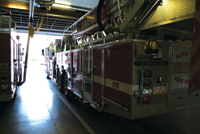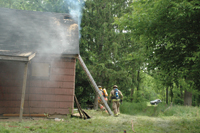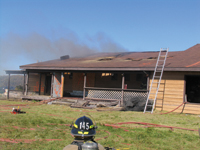
Features
Structural
Training
Back to Basics: December 2010
One of the functions of a truck company is to conduct reconnaissance on the fire ground. Whether conducted by an official truck company, a rescue company or an engine company, reconnaissance is important. Incident commanders are often frustrated because they don’t know what is going on inside and around the structure during the first minutes of the situation.
November 25, 2010
By Mark van der Feyst
One of the functions of a truck company is to conduct reconnaissance on the fire ground. Whether conducted by an official truck company, a rescue company or an engine company, reconnaissance is important. Incident commanders are often frustrated because they don’t know what is going on inside and around the structure during the first minutes of the situation. Knowing what is going on inside and outside helps the incident commander make good decisions.
Reconnaissance, a term used by the military, is the process of getting information about enemy forces or positions by sending out small groups of soldiers or aircraft. By doing this, the military is able to concentrate its efforts. The fire service has adopted this principle in relation to fire attack. If we can gather information about our enemy’s position, we can concentrate our efforts.
 |
|
| The truck company can help to gather information that will help incident command direct resources to where they are needed. Photo by Mike Gutschon |
|
 |
|
| Establishing a secondary means of egress is among the tasks assigned to the truck company. Photo by Mark van der Feyst |
Reconnaissance takes place on arrival at the scene. Reconnaissance is certainly a part of the size-up process but it does not happen continually. The truck company that arrives on scene will break up into smaller teams; one team will go inside and the other team will take care of the outside. One of these two groups will conduct reconnaissance of the structure and situation. This information will be relayed to command to be processed. Then, the incident commander can direct the other resources at hand to effectively mitigate the incident.
It’s important to remember the difference between reconnaissance and progress reports from the interior or exterior crews. A progress report informs incident command about the status of the assigned task; a reconnaissance report informs incident command about the circumstances or opposing forces that firefighters or rescuers will face. Reconnaissance refers to a complete walk-around of the structure. For most structural fires, a single person – usually the first-arriving officer – can complete a walk-around. These buildings are small enough to facilitate this. When a building is too big, too complex or connected to another building, it is difficult for one person to complete a walk-around. In these cases, a small team assigned to outside functions can complete the walk-around for exterior concerns. The small team can be assigned tasks such as laddering the structure, shutting off utilities, ventilating windows, removing obstructions, forcing entry into the structure and setting up master streams. All of these tasks allow the small team to gather information for the incident commander. The inside team will have similar assigned tasks.
Here are five areas present at all structural fires.
Fire location
The location of the fire is crucial information that the incident commander and engine company need to have. Sometimes, firefighters can see exactly where the fire is located when they arrive on scene but other times they cannot. Visible flames or smoke exiting from the structure at a certain point do not indicate fire location. These signs can be deceiving and may lead firefighters to the wrong location. The truck company can help to locate the fire when it is conducting the primary search. The inside team will have a much better vantage point, as its members will either start their search at the fire location or work toward it. When the fire location has been determined, the truck company can relay the location to the incident commander and the incoming engine company. This reduces the time it takes for the engine company to locate the fire.
Fire extension
Once the location of the fire has been determined, the inside truck team can search for fire extension. Fire extension will sometimes be the biggest and longest part of fire suppression, as it requires chasing down the fire and stopping it. Extinguishing the main body of the fire will take only a few seconds but locating and extinguishing fire extension can take time. Finding the fire extension is important as it will direct other engine companies and their suppression activities.
 |
|
| Looking for and knowing where the fire is located are part of truck company operations. Photo by Mark van der Feyst
|
Salvage operations
Salvage operations are often forgotten during structural fire ground operations. The inside truck company will identify which areas need to be salvaged right away and which areas can wait. These areas can usually be located while conducting the primary search. Quick salvage operations will avoid great financial losses for the property owner.
Secondary means of egress
The outside truck company team contributes to the inside truck company’s reconnaissance efforts by locating the secondary means of egress and possibly finding access points for aerial operations. When members of the outside team are walking around the structure, they will look for the best locations for secondary exits. The outside team members may ladder windows for this purpose or open up doors in other areas on the ground floor; either way, they will communicate this information to incident command.
Obstructions to access/egress
The outside team will identify obstructions that hinder access and/or egress from the structure. These obstructions must be removed so they will not cause problems later on. Other crews may be assigned to remove these obstructions – bars on windows, for example – based on the reconnaissance report given by the outside truck team. The initial outside team may not have the tools to remove the bars but incident command can assign another team to complete this task.
Teamwork is needed for reconnaisance to be successful, and when inside and outside truck companies co-operate, reconnaissance can make a difference in minimizing the negative impact a fire may have.
Mark van der Feyst is an 11-year veteran of the fire service. He currently works for the City of Woodstock Fire Department in Ontario. Mark is an international instructor teaching in Canada, the United States and India. He is a local level suppression instructor for the Pennsylvania State Fire Academy, an instructor for the Justice Institute of British Columbia and a professor of fire science at Lambton College. E-mail him at Mark@FireStarTraining.com
Print this page